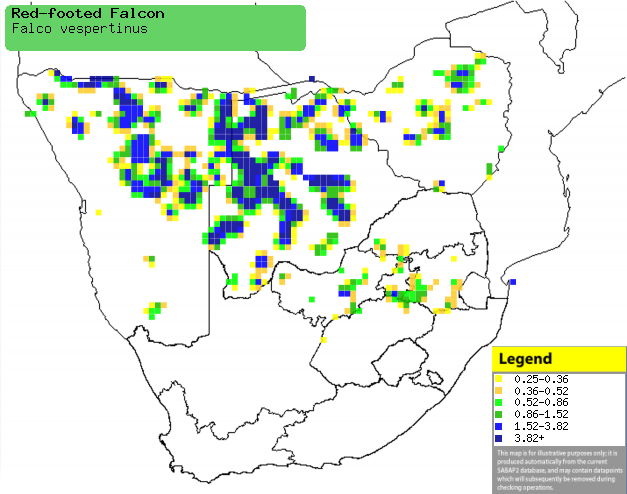|
Falco vespertinus (Red-footed
falcon, Western red-footed kestrel)
Westelike rooipootvalk [Afrikaans]; Kakodi (generic term
for sparrowhawks, goshawks, kestrels and falcons) [Kwangali]; Phakwê (generic
term for some of the smaller raptors) [Tswana]; Roodpootvalk, Avondvalk [Dutch];
Faucon kobez [French]; Rotfußfalke [German];
Falcão-de-pés-vermelhos-ocidental [Portuguese]
Life
> Eukaryotes >
Opisthokonta
> Metazoa (animals) >
Bilateria >
Deuterostomia > Chordata >
Craniata > Vertebrata (vertebrates) > Gnathostomata (jawed
vertebrates) > Teleostomi (teleost fish) > Osteichthyes (bony fish) > Class:
Sarcopterygii (lobe-finned
fish) > Stegocephalia (terrestrial
vertebrates) > Tetrapoda
(four-legged vertebrates) > Reptiliomorpha > Amniota >
Reptilia (reptiles) >
Romeriida > Diapsida > Archosauromorpha > Archosauria >
Dinosauria
(dinosaurs) > Saurischia > Theropoda (bipedal predatory dinosaurs) >
Coelurosauria > Maniraptora > Aves
(birds) > Order: Falconiformes >
Family: Falconidae
Distribution and habitat
Breeds from eastern Europe and northern Asia to
north-western China, heading south in the non-breeding season to southern Angola
and southern Africa. Within southern Africa it is locally uncommon to common in Botswana, northern
Namibia, central Zimbabwe and the area in and around Gauteng, South Africa. It
generally prefers open habitats with scattered trees, such as open grassy
woodland, wetlands, forest fringes and croplands, although it often roosts in
stands of alien trees (especially Eucylaptus) in the suburbs of small towns.
|
 |
|
Distribution of Red-footed falcon in southern
Africa, based on statistical smoothing of the records from first SA Bird
Atlas Project (©
Animal Demography unit, University of
Cape Town; smoothing by Birgit Erni and Francesca Little). Colours range
from dark blue (most common) through to yellow (least common).
See here for the latest distribution
from the SABAP2. |
Movements and migrations
Palearctic breeding migrant, departing from its
Eurasian breeding grounds from August-September before the entire
population heads to southern Africa and Angola, arriving around
October-November and staying until April and May.
Food
It mainly eats arthropods, hunting from a low perch or from
the air, diving to the ground and taking its prey, or hawking insects aerially.
It may aggregate in large flocks at insect emergences, but otherwise it forages
in loose flocks. The following food items have been recorded
in its diet:
- Arthropods
- Small vertebrates
Threats
Not threatened, although in its European grounds habitat loss and
pesticide spraying have reduced its numbers.
References
-
Hockey PAR, Dean WRJ and Ryan PG 2005. Roberts
- Birds of southern Africa, VIIth ed. The Trustees of the John Voelcker
Bird Book Fund, Cape Town.
|
